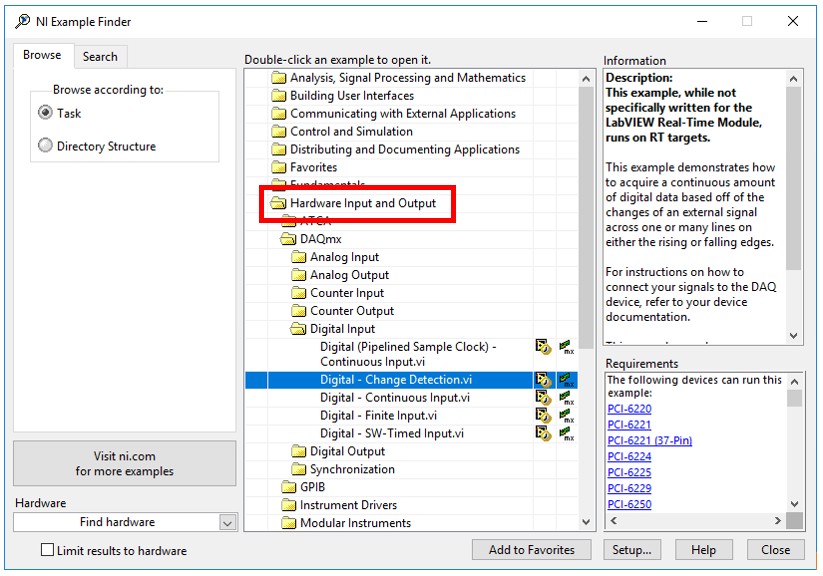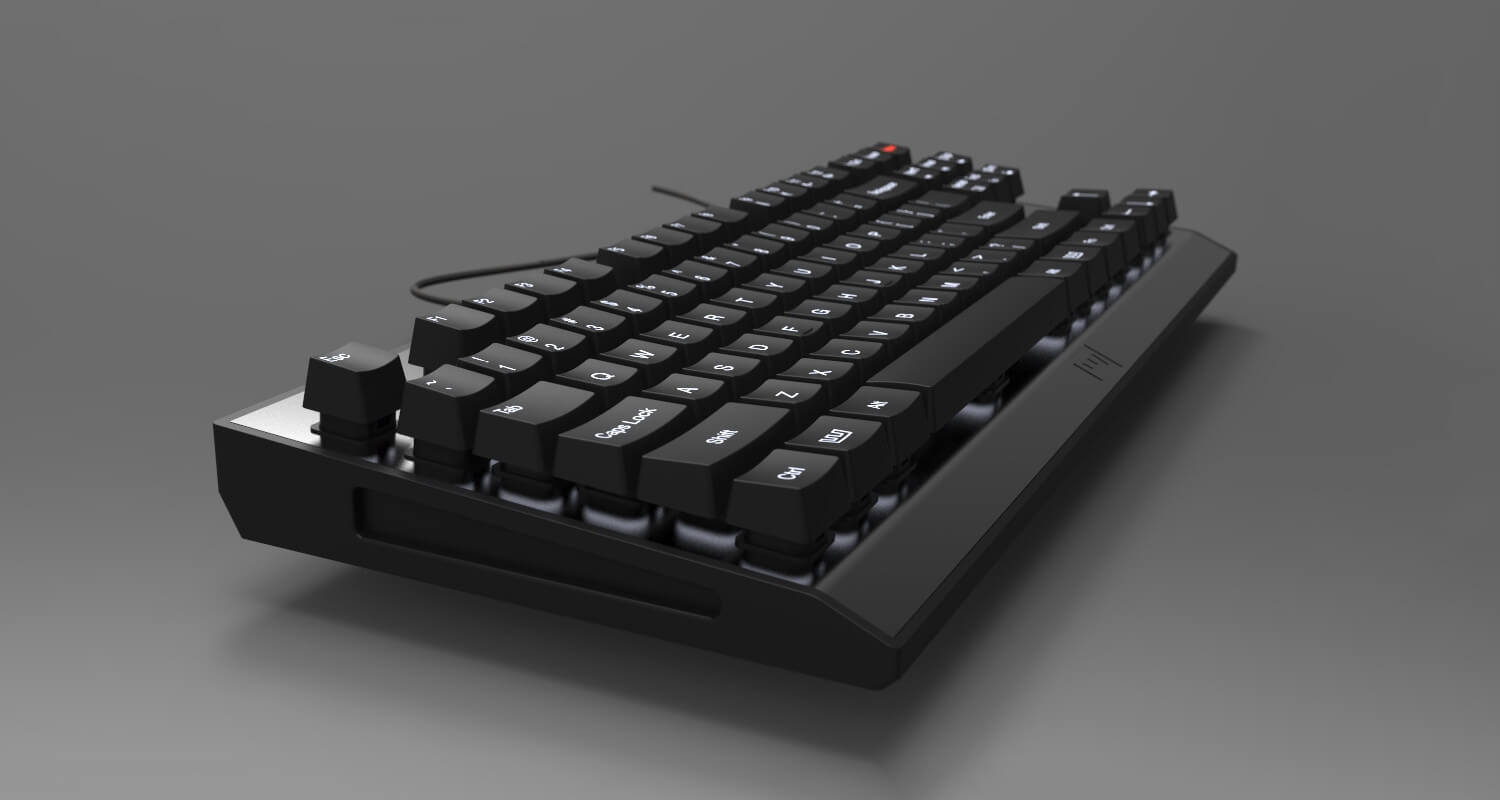The 0.5Amp 40-558 BRIC12 modules can also hold up to 18 matrix daughtercards, offering up to 9216 crosspoints, making it the industry’s highest capacity PXI matrix switch module. Like previously available 2, 4 and 8-slot versions, the new 12-slot modules feature an internal screened analog bus that maximizes signal integrity.
- Single input and 6 outputs CMOS or LVPECL (AC-coupled LVPECL available as option) 'The technical and intellectual support from the team at Teledyne SP Devices has been playing an important role in our research.'
- NI-XNET is the driver software technology behind NI-XNET CAN, LIN, and FlexRay PCI, PXI, and NI C Series interfaces. The nixnet package and NI-XNET are supported by NI. Learn more about nixnet. Python API for Traditional, Benchtop Instruments. PyVISA is a Python package that contains the API for interacting with the NI-VISA driver.
1.1. The simplest example¶
Here comes a very simple example of an input device driver. The device hasjust one button and the button is accessible at i/o port BUTTON_PORT. Whenpressed or released a BUTTON_IRQ happens. The driver could look like:
1.2. What the example does¶
First it has to include the <linux/input.h> file, which interfaces to theinput subsystem. This provides all the definitions needed.
In the _init function, which is called either upon module load or whenbooting the kernel, it grabs the required resources (it should also checkfor the presence of the device).
Then it allocates a new input device structure with input_allocate_device()and sets up input bitfields. This way the device driver tells the otherparts of the input systems what it is - what events can be generated oraccepted by this input device. Our example device can only generate EV_KEYtype events, and from those only BTN_0 event code. Thus we only set thesetwo bits. We could have used:
as well, but with more than single bits the first approach tends to beshorter.
Then the example driver registers the input device structure by calling:
This adds the button_dev structure to linked lists of the input driver andcalls device handler modules _connect functions to tell them a new inputdevice has appeared. input_register_device() may sleep and therefore mustnot be called from an interrupt or with a spinlock held.

While in use, the only used function of the driver is:
which upon every interrupt from the button checks its state and reports itvia the:
call to the input system. There is no need to check whether the interruptroutine isn’t reporting two same value events (press, press for example) tothe input system, because the input_report_* functions check thatthemselves.
Then there is the:
call to tell those who receive the events that we’ve sent a complete report.This doesn’t seem important in the one button case, but is quite importantfor for example mouse movement, where you don’t want the X and Y valuesto be interpreted separately, because that’d result in a different movement.
1.3. dev->open() and dev->close()¶
In case the driver has to repeatedly poll the device, because it doesn’thave an interrupt coming from it and the polling is too expensive to be doneall the time, or if the device uses a valuable resource (eg. interrupt), itcan use the open and close callback to know when it can stop polling orrelease the interrupt and when it must resume polling or grab the interruptagain. To do that, we would add this to our example driver:
Note that input core keeps track of number of users for the device andmakes sure that dev->open() is called only when the first user connectsto the device and that dev->close() is called when the very last userdisconnects. Calls to both callbacks are serialized.
The open() callback should return a 0 in case of success or any nonzero valuein case of failure. The close() callback (which is void) must always succeed.
1.4. Basic event types¶
The most simple event type is EV_KEY, which is used for keys and buttons.It’s reported to the input system via:
See uapi/linux/input-event-codes.h for the allowable values of code (from 0 toKEY_MAX). Value is interpreted as a truth value, ie any nonzero value means keypressed, zero value means key released. The input code generates events onlyin case the value is different from before.
In addition to EV_KEY, there are two more basic event types: EV_REL andEV_ABS. They are used for relative and absolute values supplied by thedevice. A relative value may be for example a mouse movement in the X axis.The mouse reports it as a relative difference from the last position,because it doesn’t have any absolute coordinate system to work in. Absoluteevents are namely for joysticks and digitizers - devices that do work in anabsolute coordinate systems.
Having the device report EV_REL buttons is as simple as with EV_KEY, simplyset the corresponding bits and call the:
function. Events are generated only for nonzero value.
However EV_ABS requires a little special care. Before callinginput_register_device, you have to fill additional fields in the input_devstruct for each absolute axis your device has. If our button device had alsothe ABS_X axis:
Or, you can just say:
This setting would be appropriate for a joystick X axis, with the minimum of0, maximum of 255 (which the joystick must be able to reach, no problem ifit sometimes reports more, but it must be able to always reach the min andmax values), with noise in the data up to +- 4, and with a center flatposition of size 8.
If you don’t need absfuzz and absflat, you can set them to zero, which meanthat the thing is precise and always returns to exactly the center position(if it has any).
1.5. BITS_TO_LONGS(), BIT_WORD(), BIT_MASK()¶
These three macros from bitops.h help some bitfield computations:
1.6. The id* and name fields¶
The dev->name should be set before registering the input device by the inputdevice driver. It’s a string like ‘Generic button device’ containing auser friendly name of the device.
The id* fields contain the bus ID (PCI, USB, ...), vendor ID and device IDof the device. The bus IDs are defined in input.h. The vendor and device idsare defined in pci_ids.h, usb_ids.h and similar include files. These fieldsshould be set by the input device driver before registering it.
The idtype field can be used for specific information for the input devicedriver.

The id and name fields can be passed to userland via the evdev interface.
1.7. The keycode, keycodemax, keycodesize fields¶
These three fields should be used by input devices that have dense keymaps.The keycode is an array used to map from scancodes to input system keycodes.The keycode max should contain the size of the array and keycodesize thesize of each entry in it (in bytes).
Userspace can query and alter current scancode to keycode mappings usingEVIOCGKEYCODE and EVIOCSKEYCODE ioctls on corresponding evdev interface.When a device has all 3 aforementioned fields filled in, the driver mayrely on kernel’s default implementation of setting and querying keycodemappings.
1.8. dev->getkeycode() and dev->setkeycode()¶
getkeycode() and setkeycode() callbacks allow drivers to override defaultkeycode/keycodesize/keycodemax mapping mechanism provided by input coreand implement sparse keycode maps.
1.9. Key autorepeat¶
... is simple. It is handled by the input.c module. Hardware autorepeat isnot used, because it’s not present in many devices and even where it ispresent, it is broken sometimes (at keyboards: Toshiba notebooks). To enableautorepeat for your device, just set EV_REP in dev->evbit. All will behandled by the input system.
1.10. Other event types, handling output events¶
The other event types up to now are:
- EV_LED - used for the keyboard LEDs.
- EV_SND - used for keyboard beeps.
They are very similar to for example key events, but they go in the otherdirection - from the system to the input device driver. If your input devicedriver can handle these events, it has to set the respective bits in evbit,and also the callback routine:
This callback routine can be called from an interrupt or a BH (although thatisn’t a rule), and thus must not sleep, and must not take too long to finish.
Browse the products below by using the tabs to view different product categories and scroll down to show the full range of products.
14-Bit Digitizers
div > .uk-panel', row:true}'>ADQ7DC
- Single/dual channel
- Up to 10 GSPS sampling rate
- Up to 3 GHz input bandwidth
- DC-coupled
ADQ14DC
- Single/dual/quad channel
- Up to 2 GSPS sampling rate
- Up to 1.2 GHz input bandwidth
- DC-coupled (variable input range/gain optional)
ADQ14AC
- Single/dual/quad channel
- Up to 2 GSPS sampling rate
- Up to 1.2 GHz input bandwidth
- AC-coupled
ADQ14OCT
- Single channel
- 2 GSPS sampling rate
- 500 MHz input bandwidth
- DC-coupled
- Optimized for swept-source OCT, supporting variable K-clock
SDR14
- Dual inputs, dual outputs
- 800 MSPS input rate, 1.6 GSPS output rate
- 550 MHz input bandwidth, up to 800 MHz output bandwidth
- AC-coupled (DC-coupling optional for output)
ADQ1600RF
- Single channel
- 1.6 GSPS sampling rate
- 750 MHz input bandwidth
- AC-coupled
- Optimized for RF applications requiring high input bandwidth
ADQ1600TD
- Single channel
- 1.6 GSPS sampling rate
- 680 MHz input bandwidth
- AC-coupled
- Optimized for time-domain applications
ADQ114
- Single channel
- 800 MSPS sampling rate
- 850 MHz input bandwidth
- AC-coupled
ADQ214-DCLN
- Dual channel
- 400 MSPS sampling rate
- 100 MHz input bandwidth
- DC-coupled
- Optimized for low-noise measurements
Drivers PXI Input Devices
ADQ214
- Dual channel
- 400 MSPS sampling rate
- Up to 850 MHz input bandwidth
- AC- and DC-coupled (software selectable)
12-Bit Digitizers
div > .uk-panel', row:true}'>ADQ32NEW!
- Dual channel
- 2.5 GSPS sampling rate
- 1 GHz input bandwidth
- DC-coupled
ADQ7WB
- Dual channel
- Up to 5 GSPS sampling rate
- 6.5 GHz input bandwidth
- AC-coupled
ADQ412
- Dual/quad channel
- Up to 4 GSPS sampling rate
- Up to 2 GHz input bandwidth
- AC-coupled
ADQ412DC
- Dual/quad channel
- Up to 4 GSPS sampling rate
- Up to 925 MHz input bandwidth
- DC-coupled
10-Bit Digitizers
 div > .uk-panel', row:true}'>
div > .uk-panel', row:true}'>ADQ8-8C
- 8 analog channel
- 1 GSPS sampling rate
- 500 MHz input bandwidth
- DC-coupled
ADQ8-4XNew!
- Dual/quad channel
- Up to 4 GSPS sampling rate
- 1 GHz input bandwidth
- DC-coupled
8-Bit Digitizers
div > .uk-panel', row:true}'>ADQ108
- Scheduled for termination
- Single channel
- 7 GSPS sampling rate
- 2 GHz input bandwidth
- AC-coupled
ADQ208
- Scheduled for termination
- Dual channel
- 4 GSPS sampling rate
- 2 GHz input bandwidth
- AC-coupled
Waveform Generators
div > .uk-panel', row:true}'>SDR14
- Not recommended for new designs
- Dual inputs, dual outputs
- 800 MSPS input rate, 1.6 GSPS output rate
- 550 MHz input bandwidth, up to 800 MHz output bandwidth
- AC-coupled (DC-coupling optional for output)
SDR14TX
- Dual outputs
- 2 GSPS sample rate
- Up to 1.8 GHz output bandwidth
- DC-coupled, single-ended and differential
Extension Modules
div > .uk-panel', row:true}'>
ADQ10GBE
- 10 Gbit Ethernet card
- PXIe form factor
ADQDSU
- Not recommended for new designs
- SSD disk storage unit for high-speed data recording
- Up to 2 TBytes total storage
- Up to 1 GBytes/s write speed

ADQDSP
Drivers Pxi Input Devices Speed Sensor
- Scheduled for termination
- FPGA computational board
- Xilinx Virtex 6 LX240T
Drivers Pxi Input Devices Bluetooth
ADQTDU
Drivers Pxi Input Devices Adapter
- Not recommended for new designs
- Trigger/clock distribution for intra-board synchronization
- Single input and 6 outputs
- CMOS or LVPECL (AC-coupled LVPECL available as option)
